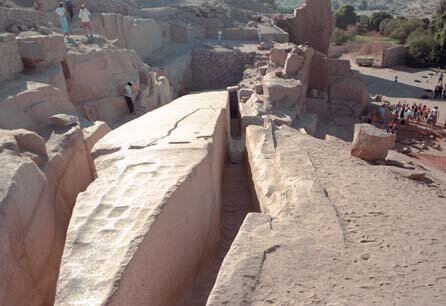Baalbek. Despite the smarmy tone of your phrasing, 'please do enlighten us,' I'll post a summary of why it's explained. In my several hundred posts on this site, you'll find very few that use the sarcasm or insulting terms that you are happy to use. It was the same poor attitude that prompted my first response to you.
Okay. I'll try and explain some reasons why I don't think Baalbek is older than the Roman Empire circa 1st Century AD. Neither do I believe the Romans used any exotic technology or had the assistance of ancient astronauts or devices that helped them to levitate the stones. My position on all the ancient megaliths and monuments is that humans designed and constructed them using the technology and tools available at the time.
Baalbek was a strategic location between the cross-roads of Egypt, Syria and Mesopotamia-Phoenicia. It had great importance to the Romans and when they took control they quickly began the construction of major temples. True to form, they made allowances for local culture as they did across Europe. The Temple for Bacchus became the largest complex of the Roman era. They adapted the regional water resources to include springs as part of the complex and to provide water for the population. These springs also appealed to the native population's beliefs that viewed water as sacred and was a place of pilgrimage. Given its location and the political and social pressure to be impressive and indicative of their massive power, they set out to build a complex unusual in scale.
This is where academic researchers and 'forbidden archaeologists' go in separate directions. The great size of the platform stones, the 'Trilithon,' has led a lot of people to conclude that the Romans couldn't have managed to move these stones and therefore they must originate in an unknown time. Guesses about *who* built them varies depending on the beliefs of those writing the books or hosting the websites.
Between 600 and 800 tons is the weight generally given to these stones. That's pretty heavy stuff. A German archaeological team in early 1920s excavated down to the bedrock of the stones and found Roman waste and debris. They also noted that the rear of the stones are more concave and honey-combed like much of the Roman style of monument-building. In the centuries before the Romans arrived at Baalbek, the Egyptians had a brisk business in carving and erecting obelisks. The biggest of which is called the 'Unfinished Obelisk.' It lies in the quarry after an unforeseen fissure caused it to crack along the weakest plane. 1100 tons is the estimated weight. Its surface is pitted with the strikes of diorite hammers used to carve it. Along two sides are the straight lines of pits the quarrymen would use to break the stone from its bedding plane.
The Egyptians had managed to successfully carve obelisks weighing in at up to 700 tons and erect them. The Romans admired these huge objects and began taking them to Rome in the 1st Century. One of the heaviest is the Lateran Obelisk at up to 600 tons. They hauled its ass to Rome during the time they were constructing the Baalbek temples. Last year, in another thread, I worked it out to be some 1300 miles! Smaller obelisks of around 300-400 tons were also taken to Rome.
The Baalbek stones were moved just 1200 feet downhill from the quarry they were carved from. In the light of the Roman's transportation of the obelisks, this feat loses the sense of mystery we see in some sites and books.
How were the stones transported from the quarry is the next question you'd be wondering about? By the time of Baalbek, the Romans were using great windlasses anchored into the ground with huge iron stakes. These techniques have been recorded in the records in different parts of the Empire. They continued using the same method of moving great weights for the next 1500 years and employed them to erect the Lateran Obelisk at St Peters Basilica. At Baalbek, they'd clear the landscape of obstacles to ensure a level downhill passage. Using the system of windlasses and the use of draft animals to augment teams of men, they'd move these stones slowly and surely down hill to their final resting places. It could take months, but they were there for decades. The massive 1200 ton block that remains in the quarry was carved with the intention of being moved and maybe regional or political changes ensured it stayed there?
Here's an interesting link to add more detail to the Roman use of windlasses/winches and the techniques they used in constructing their monuments...
http://books.google.com/books?hl=en&lr=&id=IISfZt_-ZgQC&oi=fnd&pg=PP3&sig=MJSDRfsH7aJbXU3wvS1M_hK5Mdo&dq=baalbek+trilithon#v=onepage&q=baalbek%20trilithon&f=false (pages 24-38)
Here's the 'Unfinished Obelisk'...
http://www.egypt-nile.co.uk/unfinished_obelisk.htm

Moving the Vatican Obelisk with windlasses...
http://pruned.blogspot.com/2007/05/moving-vatican-obelisk.html
The Russians moved a 1500 ton stone without animals:
http://en.wikipedia.org/wiki/Bronze_Horseman#The_Thunder_Stone
I don't wish for my words to be insulting. But the fact is, i believe I have successfully challenged everything you have claimed so far!
You obviously have skipped, or avoided expressing opinions on lot of what I posted last, maybe you had no time o do so, or just had no opinion either way, but I believe again I raised issues that contradict lot of what you had to say!
Before I get started. The most interesting link for me personally, and it's information that i wasn't aware of is the Thunder Rock. Really fascinating stuff, and it does open up other options to consider no doubt. The movement of the stone occurred in the 18th century, so you have to taken that into consideration the level of engineering expertise, and nohow available at the time in history!
It is often said, the further we look back in history, the less sophisticated the technology becomes! According to the Historians Baalbek, was build hundreds of years before this event took place! We most also taken into consideration too the dimensions of the Thunder Rock, it was very bulky not overly long, often the longer the object is the greater difficulty of transporting from one place to the other.
But I still must admit again it does show us large rocks and stones can be transported with effort, and nohow when the conditions are correct, and no spaceships or mystical practices in the movement of large stones is required!
What I claim next is factual can not be disputed by academics scholars writers of history no one. We both are hotly debating the large stones at Baalbek Lebanon, and the origins of the stone. Who the Romans?.. or someone else?
Here is a couple or more facts that historians do not dispute or claim is not true!
There is No Roman records that claim having build the incredible retaining wall!
There is no record of actually how the Romans transported the stones from one location to the next, it just speculation I'm afraid! You have posted information that is purely speculation, well it reads nice on paper, but we have no evidence it happened the way you said it had!
Romans capabilities of transporting large rocks or stones, seems to have been limited to weights of 300 or 400 tons.. I will address the Obelisks transporting from locations in Egypt to Rome Italy shortly, the Romans had previously tried to manage higher weights, but were unsuccessful in doing so, and like I said above, will outline the well-documented history of what I claim.
Scholars and History Buffs, a number of them, scoff at the idea that the Romans had not brought the great blocks of stone to the temple site. Here lies the problem. Megalithic stone construction is not a Roman style, buildings of this type were not constructed during Roman rule in the Middle east.
Romans had started using concrete for all building work, you want an example of the Roman style, perfect example is the Colosseum in Rome (concrete)
Baalbek, also has a well-established history, before the Romans. The Temple of Jupiter was build on top of the platform, that was already there. The three large stones the Trilithon were already placed, and the Romans build over the previous temple that was already there!
As regards to the weight of the stones., The stones are over 800 tons!
Historians claim a lower weight, well to stop people questioning the logic of the Romans having transported the blocks of stone from one location to the next! The less weight the blocks are, the easier it is to claim the Romans had moved the stones!
Another reason why we know that all the blocks of stone were not brought there to the site, is erosion!
Some of the blocks, have a different color and texture. Which basically was caused by weather patterns, time out in the sun and construction time. Erosion of some of the stone blocks, is the killer, and this geological evidence categorically without question in my mind, confirms many of the large stones were there before the Romans arrived, and started construction of the Temple of Jupiter (still alleged only) over the previous Old temple that was build for the "GOD Baal" around 2,000 years previously.
The stone left at the quarry is a estimated 1, 170 tons, and it still mystery why is was left behind?
You've speculated, But maybe it was just too big for the retaining wall? It was the largest of the block stones, the others were slightly smaller than that one 800 to 1000 tons?
I have lot more information, that I could post at a later time. The history of the area, the peoples that once occupied the lands, and other important factors which solidly support my position, but I will wait to see what you have to say, before replying further.
Before I end the post as I said I would!
The Obelisks, you have previously brought this issue up before, ok let me be clear. Lot of the Obelisks were brought over from Egypt in pieces so to reduce the weight and none were over 400 tons. I honestly, have no clue were you got the the figure of 600 tons or more?
The accurate weight of the Lateran Obelisk is 330 tons, but I have to admit and be honest, 4m of the obelisk was lost during the 1587 restoration, but 4m would still not account for the extra 270 tons you mentioned!
I have accurate weight on other Obelisks brought over by the Romans, but all were and still are below the figure of 400 tons.
Again, you see the dilemma we face, the records from Rome show weights of over 400 tones were never transported successfully, if you require an example ok!
Emperor Augustus of Rome, conquered Egypt in 27BC, he then went on, and ordered that the obelisk at the "Karnak Temple"in Egypt be transported to Rome. Well it is well-documented recorded by the Romans, that that effort was aborted, when his prize proved too heavy to lift!
Here we are shown the limited capabilities of the Romans in transporting larges stones across large distances, the weight of the Obelisk was between 323-455 tons also according to the Romans!
This kind of does make a mockery of the argument, the Romans had the ability to move stones well over 800 tons or more!



